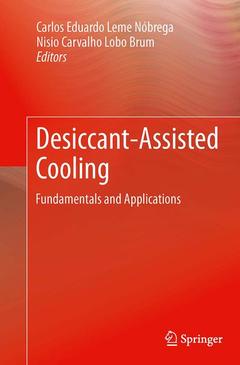Description
Desiccant-Assisted Cooling, Softcover reprint of the original 1st ed. 2014
Fundamentals and Applications
Coordinators: Nóbrega Carlos Eduardo Leme, Brum Nisio Carvalho Lobo
Language: English
Subject for Desiccant-Assisted Cooling:
Publication date: 08-2016
Support: Print on demand
Publication date: 12-2013
281 p. · 15.5x23.5 cm · Hardback
Description
/li>Contents
/li>Biography
/li>Comment
/li>
The increasing concern with indoor air quality has led to air-quality standards with increased ventilation rates. Although increasing the volume flow rate of outside air is advisable from the perspective of air-quality, it is detrimental to energy consumption, since the outside air has to be brought to the comfort condition before it is insufflated to the conditioned ambient. Moreover, the humidity load carried within outside air has challenging HVAC engineers to design cooling units which are able to satisfactorily handle both sensible and latent contributions to the thermal load. This constitutes a favorable scenario for the use of solid desiccants to assist the cooling units. In fact, desiccant wheels have been increasingly applied by HVAC designers, allowing distinct processes for the air cooling and dehumidification. In fact, the ability of solid desiccants in moisture removal is effective enough to allow the use of evaporative coolers, in opposition to the traditional vapor-compression cycle, resulting in an ecologically sound system which uses only water as the refrigerant.
Desiccant Assisted Cooling: Fundamentals andApplications presents different approaches to the mathematical modeling and simulation of desiccant wheels, as well as applications in thermal comfort and humidity controlled environments. Experts in the field discuss topics from enthalpy, lumped models for heat and mass transfer, and desiccant assisted radiant cooling systems, among others.
Aimed at air-conditioning engineers and thermal engineering researchers, this book can also be used by graduate level students and lecturers in the field.
An Introduction To Solid Desiccant Cooling Technology.- Status of Liquid Desiccant Technologies and Systems.- Mathematical Modeling of Heat and Mass Transfer in Regenerators with Desiccant Materials.- Influence of Altitude on the Behavior of Solid Desiccant Dehumidification System.- The Performance of Desiccant Wheels for Desiccant Air-Conditioning.- Separate Sensible and Latent Cooling.-Membrane-based liquid-to-air energy exchangers.- Adsorption/Desorption Characteristics of Solid Particles in Desiccant Bed for Different Design Configurations.- Desiccant dehumidification integrated with hydronic radiant cooling.- Desiccant Cooling.
Carlos Eduardo Leme Nóbrega is an Adjunct Professor in the Mechanical Engineering Department at the Centro Federal de Educação Tecnológica Celso Suckow da Fonseca, CEFET-RIO, since 2004. He received his P.E. in Mechanical Engineering from the Pontifícia Universidade Católica do Rio de Janeiro (PUC/RJ), Brazil in 1993 and M.Sc. in 1997 from the same university. After working as professional engineer for two years, he was accepted at COPPE/UFRJ where he obtained his PhD in 2003. Prof. Nóbrega has authored more than 30 papers in International Conferences and peer revised journals, with main interest in thermal storage and desiccant cooling simulation. He has also contributed to consulting engineering projects at companies from public and private sectors.
Nisio C. L. Brum is an Associate Professor in the Mechanical Engineering Department at the EP/COPPE/UFRJ, Federal University of Rio de Janeiro. He received his P.E. in Mechanical Engineering from the Pontifícia Universidade Católica do Rio de Janeiro (PUC/RJ), Brazil in 1974. After working as a professional engineer in an international consulting engineering company he went back to the university and received his M.Sc. in 1979 and his Ph.D in 1989 both from COPPE/UFRJ. His doctorate was under the supervision of Professor M.N. Ozisik and the research was conducted at the Mechanical & Aerospace Engineering Dept. from North Carolina State University from 1984 -1987. He established the Laboratory of Transmission and Technology of Heat and headed for a ten years period the Mechanical Engineering Department, both at COPPE/UFRJ. His research areas of interest include thermal design of heat exchangers, numerical and experimental analysis of air conditioning systems and equipments.
Addresses the mathematical modeling of desiccant wheels
Presents a variety of applications in air-conditioning systems
Provides discretized equations, fluxograms, apparatus schematics and data specifications wherever possible so that experiments may be reproduced

